Introduction to PVsyst: The Best Solar Design Software for 2021 – GSES International
Mục lục bài viết
What is PVsyst Software?
PVsyst Software is a comprehensive solar design tool used by thousands of engineers globally. PVSyst is the standard for large and utility-scale solar installations. It makes grid-connected PV systems easier to design.
PV Engineers and designers should know how to use PVsyst if they want to work in large scale solar. Jobs in this field often require PVsyst experience, especially Utility-Scale Solar.
Engineers, designers and project managers can use PVSyst to predict the energy and financial output of a solar power plant. Simulations save time by optimizing the design based on equipment specifications and their configuration.
Simple solar design or advanced solar simulation?
PVsys offers two levels of solar simulation, Preliminary and Project Design.
- Preliminary design is a rapid estimation tool. It’s perfect for pre-sales designs because you can create them in minutes.
- Project Design is where engineers will simulate profitable solar systems. These designs require hundreds of parameters and decisions. Having gathered more quality data, engineers will be more confident in their simulated output.
Which systems can be designed and simulated with PVsyst?
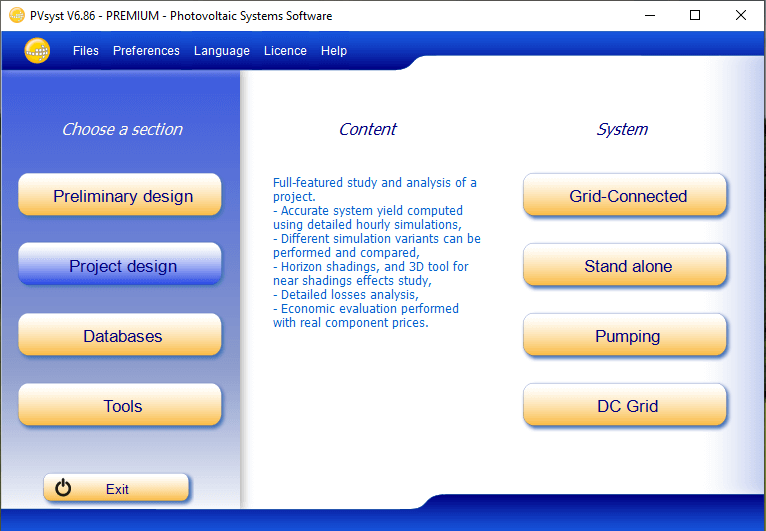 PVsyst Version 6 Dashboard
PVsyst Version 6 Dashboard
Grid-connected systems. This is the most popular simulation tool. Engineers can model the energy conversion and losses at every step of the process. The simulation outputs expected energy production, performance ratio, financial numbers. You can design multi-megawatt solar tracking systems or commercial systems as well.
Stand-alone systems. Off Grid or Stand alone Systems use batteries and generators to replace the grid. These systems are complex and you need to know detailed energy consumption and a per-hour daily energy profile. For example, PVSyst can also design high, medium, and small power stand-alone PV systems, which typically range from 50 to 300W.
Pumping systems. Solar Pumps are generally used in agriculture. Recently, it has become popular to mount modules on single-axis trackers, which allows incorporating this technology into design procedures. PVSyst offers an overview of water needs, water pumped, pump energy and efficiency.
DC Grid: DC Grid is only available on Project Design
What are the main features of PVsyst Software?
System Sizing: PVsyst offers a Visual Tool for sizing and balancing systems. It is useful for understanding various aspects of a system and determining where additional efforts should be made. PVsyst provides real-time information about the system’s size and constraints. You can also select which states will be active in the system.
System Design: System Design Board gives you all the relevant data in an easy-to-digest format so that you can start designing your system right away.
Simulations, Reports and Economic Evaluation: Users have access to several simulation features, including a daily overview of all energy levels on the system and reports of selected areas during operation. PVsyst uses advanced simulation algorithms to visualize how the system operates in real-time, helping operators understand the system as a whole.
PV Syst Tools
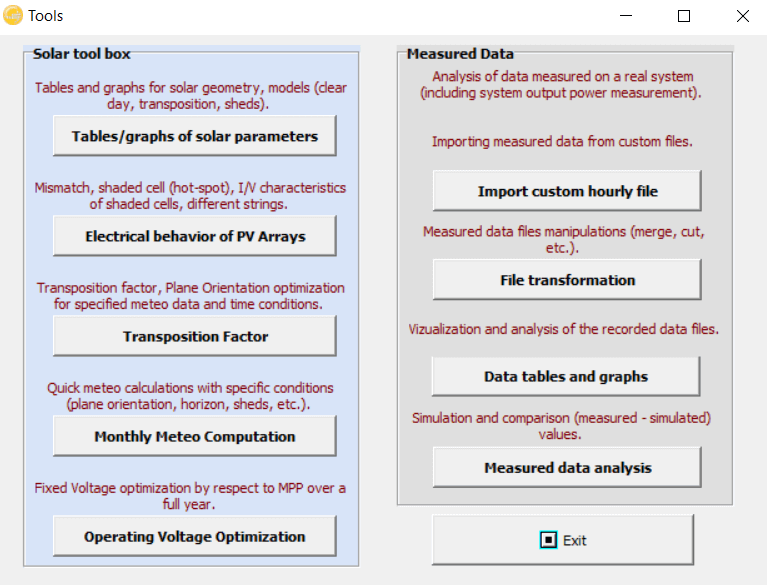 There are 5 solar tools and 4 data analysis we can use outside of a PVsyst simulation.
There are 5 solar tools and 4 data analysis we can use outside of a PVsyst simulation.
- Solar Parameters Tables: Use this tool to keep track of hundreds of variables.
- Electrical Behavior or PV Arrays Tool: Use this tool is to analyze and cell level shading effects.
- Transposition Factor Tool: This is used to optimize the energy gained from tilting solar panels.
- Monthly Meteo Computation Tool: This is used for quick solar irradiance calculations, eg Peak Sun Hours/ Monthly kWh.
- Operating Voltage Optimization Tool: In some small solar designs, an MPP tracker may not be the best choice. This tool helps decide.
Moreover, data analysis tools can help clean and transform bulk data sets. Ensuring your meteorological data is accurate and error-free is essential.
How Solar PV Designers can Benefit from Using PVsyst
PV System design tools such as PVsyst give professional designers and installers an edge in a highly competitive market. PVsyst offers users a more efficient way to install solar panels by consolidating instruments and software for system management into a single platform. Here, we share some key benefits:
Built-In Meteorological Data
PVsyst can import and solar radiation data, but also has a Meteonorm and NASA data link built-in. If you don’t have accurate solar data available don’t fear! You can generate a synthetic hourly weather file with a few clicks. You can easily find weather data anywhere at any time using Meteonorm, a third-party software that provides a vast database of thousands of weather sites from around the world.
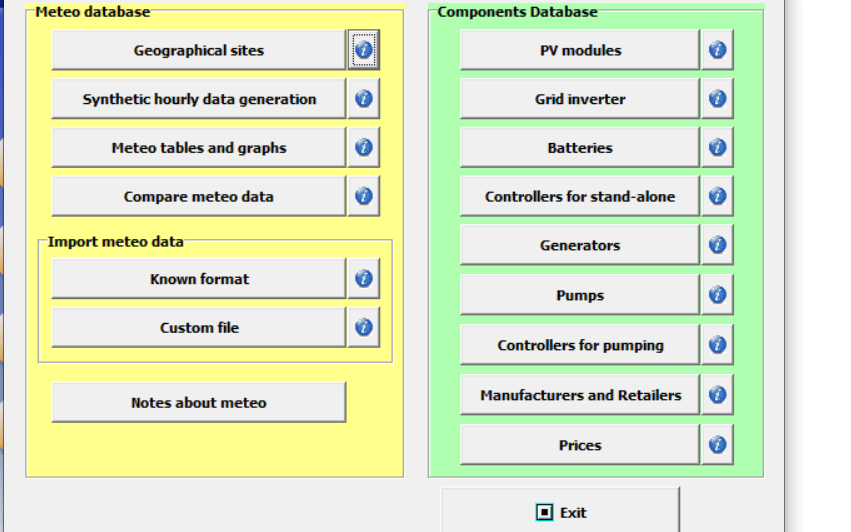 PVsyst provides access to a number of meteorological data sources on the web and includes a tool to easily import them.
PVsyst provides access to a number of meteorological data sources on the web and includes a tool to easily import them.
Huge Equipment Library
The equipment library contains thousands of PV Modules, Inverters, batteries, generators and pumps. These make using market available products easy and are regularly updated. In addition, PVSyst offers a number of capabilities that allow us to add/import the most recent solar PV modules, inverters, etc. If Sunpower releases a new module, for example, you can simply import the module’s .PAN file into PVSyst.
Powerful simulations
PVsyst allows you to simulate your energy usage on any given day in real-time and view overall system performance. By simply clicking, you can find out how much electricity you use, how much energy your battery bank receives, and how much electricity each component in the system uses.
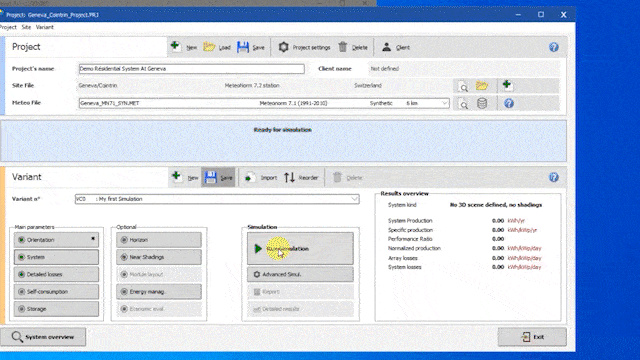 PVsyst 7 Project Simulation Tool
PVsyst 7 Project Simulation Tool
3D Shading Scene Analysis
The influence of shading on modules can be one of the most critical considerations for solar designers. You can create a 3D shading environment with PVSyst to mimic the shading objects and the losses of energy.
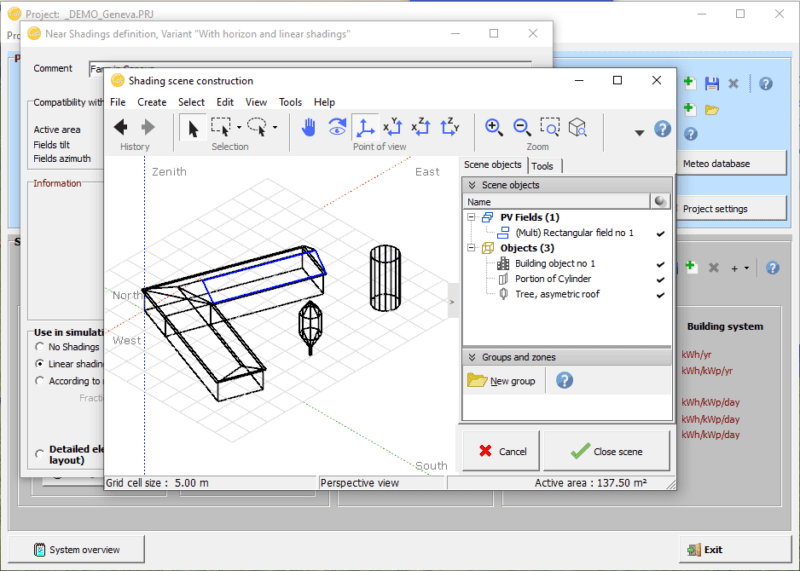 Since PVsyst version 6.60, it is possible to import shading scenes from other CAD software.
Since PVsyst version 6.60, it is possible to import shading scenes from other CAD software.
How Do I learn PVsyst Software?
PVsyst is an enormously powerful piece of software, and not the easiest to learn either. There are hundreds of parameters that need to be input into a solar simulation. Knowing how to use the software is one thing. Knowing what inputs to feed the model is another. A good PV designer knows inputs are based on good data and makes good estimates where they can. As they say with any simulation, garbage in, garbage out.
When you are ready to jump-start your career purchase our course: Introduction to PVSyst: Grid-Connected Solar. This is an online video-based course that provides a introduction to designing and simulating grid-connected PV systems. At the end of the course, there is also a simulation-based assessment. Here you will apply your new knowledge in a real design scenario.
The course is particularly relevant for those with Grid-Connected PV design experience wishing to expand their knowledge into software-based system design and energy modelling.
How much does PVsyst Software Cost?
PVsyst has changed its pricing for Version 7 in 2021. As always, you can download a 30-day free trial, but there is now a subscription model. PVsyst is based in Switzerland, so they charge 700 CHF or Swiss francs. This is about $660 USD Per Year at the time of writing.

Introduction to PVsyst: Grid-Connected Solar
AUD
239.00
Add to cart











